Alphabetical index:
|
Č D G CH K |
M P S T |
V W Z |
|
Č D G CH K |
M P S T |
V W Z |
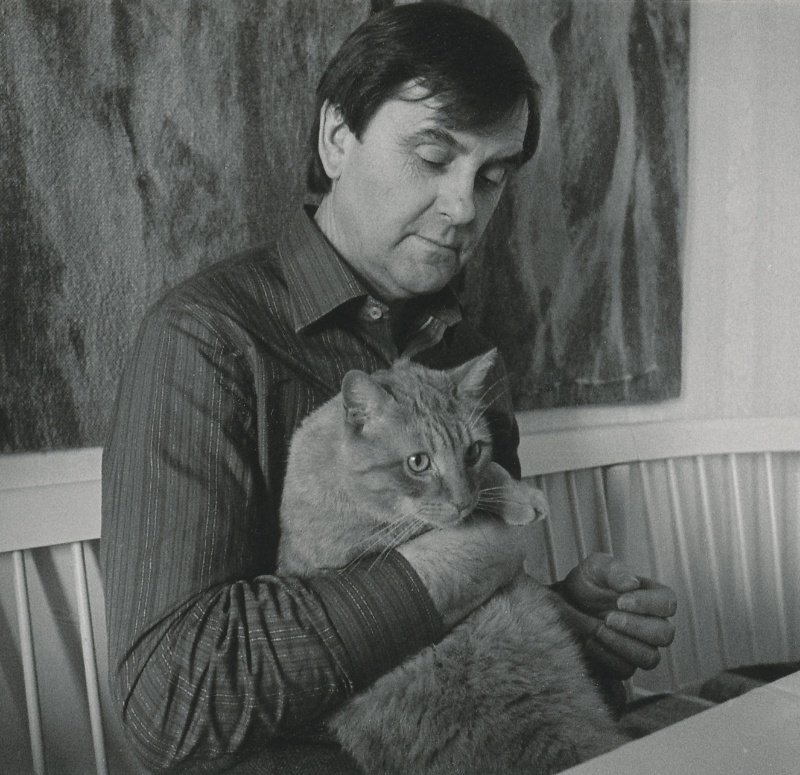
(*1930)
Work: Emblem of the Faculty of Mining and Geology / Slice of Earth
Lumír Čmerda was born in Pilsen in 1930. He graduated from the Hus’s Czechoslovak Theological Faculty in Prague in 1954 and was ordained a pastor of the Czechoslovak Hussite Church. At the same year, he followed his wife to her pastoral service in Vratimov, while himself undergoing military service with auxiliary technical battalions at mines in Karviná. After, Lumír Čmerda served a pastor in several parishes of the Ostrava region, but in 1963 was stripped of his state approval for the performance of the pastoral profession. His former artistic hobby became a source of livelihood – from 1964 to 1967 he obtained the position of display artist for the Ostrava Park of Culture and Rest and between 1967–1970 he joined the Department of the Chief Architect of Ostrava. Since 1964 he was a member of the Creative Group Kontrast, from 1967 a member of the Union of Czechoslovak Fine Artists. In 1973, due to the unfavourable existential situation, he moved back to Prague but, continued to affect the region through his further artwork for architecture. In addition to dozens of wooden reliefs, he is also the author of a number of book illustrations, to which he has devoted most of his work life after 1989.
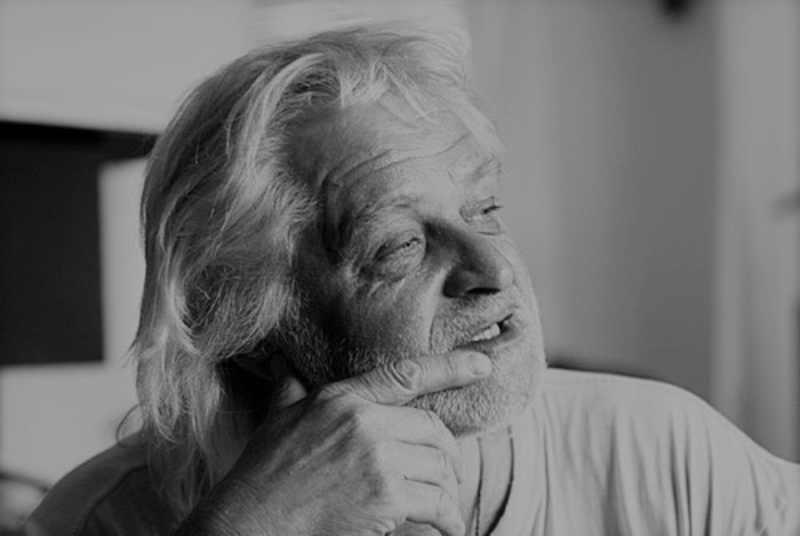
(*1958)
Work: In the Beginning Was the Wheel / Scientific-Technical Revolution
Pavel Drda was born in Hranice. In the years 1973–1977, he studied at the Secondary School of Ceramics in Bechyně, and in 1983 he graduated from the Academy of Arts, Architecture and Design in Prague under Professor Josef Malejovský. Although his work does not limit itself to a single material, he has always preferred to work with clay. Already during his studies, he created impressive sculptures of animals and dynamic figures (for example Skateboard, 1981). Later in his work, the figure dominates – whether symbolically conceived or playfully stylized. His works for architecture and public space can be found across in several places across the Czech Republic, but most can be found in the Vsetín area (Karolinka, Vsetín, Francova Lhota, Horní Bečva) and in the Moravian-Silesian Region (Polanka nad Odrou, Orlová, Klimkovice, Ostrava, Kopřivnice). Pavel Drda has long been living and working in Bystřička near the town of Vsetín.
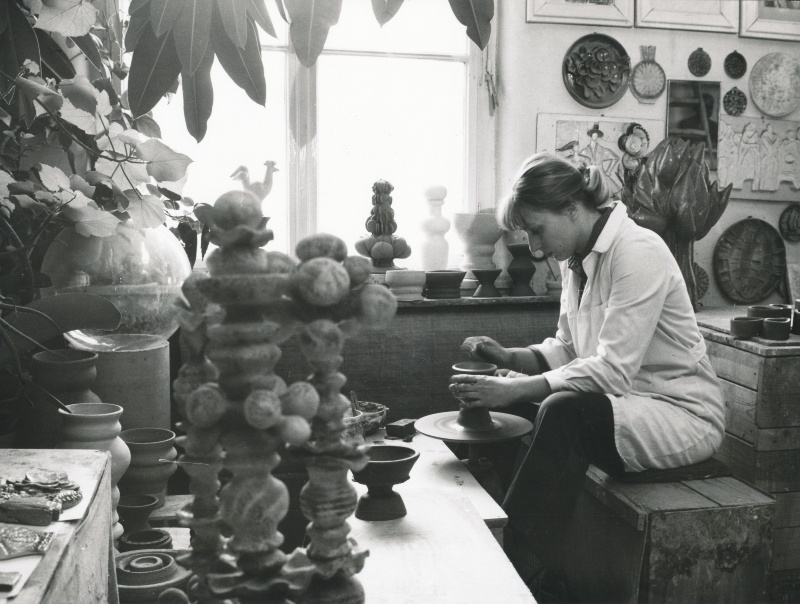
(*1948)
Work: The World of Children / The Tree
Jana Chrásková was born in Opava. Between 1963 and 1967 she studied ceramics at the Secondary School of Applied Arts in Uherské Hradiště under Stanislav Mikuláštík. She continued her studies at the Academy of Arts, Architecture and Design in Prague under Otto Eckert, from where she graduated in 1973. Her artwork is characterized by predominant lyrical, natural themes, but also by some faces and figures made of potter’s ceramics. Most of Chrásková’s work is decorated with glaze (sometimes sprayed) in natural pastel colours. The realization for architecture dates back to the year 1973. These include, in particular, reliefs (e.g. The Beskydy Mountains at the Čeladná Primary School (1977), The Birds for the post office in Ostrava – Mariánské Hory (1977), Man and Woman in the Ceremonial Hall in Vítkov (1980), or Ostrava in the Mining Institute, the Czechoslovak Academy of Sciences in Ostrava-Poruba (1985), but also decorative sculptures (jardinier The Birds for the Ostrava-Poruba District VIII (1977), The Fairy-tale Children’s World in a garden of the Vítkov kindergarten (1981), and The Plant in Ostrava-Zábřeh (1982). Since 1974 she has been a member of the Union of Czech Fine Artists.
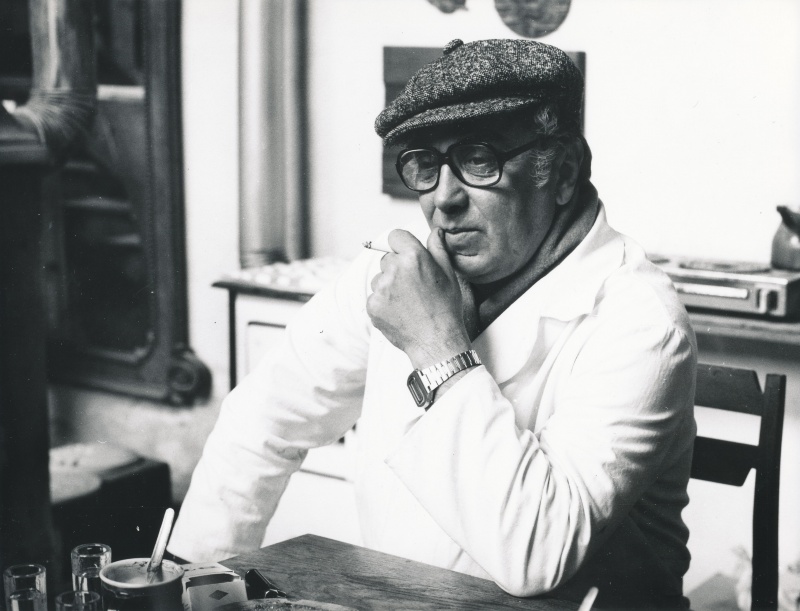
(1925–2010)
Work: Prometheus/Expansion of Science, Technology and Civilization
Coal and Iron / The Birth of Coal
Vladislav Gajda was a graduate of the State Secondary School specialized in sculpture and stonemasonry in Hořice (1945–1949) and the Academy of Fine Arts, the studio of Jan Lauda (1949–1954). He lived and worked in Ostrava all his life. Vladislav focused mainly on free monumental sculptures and on the connection of sculptural installation and architecture. His collaboration with architects, especially with Ivo Klimeš, is significant. By chosen morphology, he showed respect for the spatial layout, the need for expression, and the message content. In this way, he filled a formal scale from the realistic position (The Coal Mining, Slezská Ostrava, 1959) to a non-figurative position (Cemetery Stele, the Central Cemetery in Slezská Ostrava, 1959–1971; Prometheus, Expansion of Science, Techniques and Civilization, the facade of the Rectorate building at VŠB-Technical University in Ostrava, Poruba, 1968–1973; Rock Wall, Kačerov metro station in Prague, 1972–1973, etc.). In 1964 Vladislav Gajda visited, together with other Czechoslovak artists, the studio of the British sculptor Henry Moore, which strongly motivated him to reduce the specific details.
(1913–2004)
Work: Ostrava in the Day and Ostrava at Night
Shortly before the outbreak of the war, Josef Kolář attended for one year Special Graphic Courses under the Academy of Fine Arts in Prague led by František Šimon Tavík. After the war, he continued studying painting under Jakub Obrovský, and again graphic design under Vladimír Silovský. In the post-war era, he went travelling and visited many European and Middle Eastern countries. Josef Kolář lived and worked alternately in Prague, Ostrava, and Havířov. His painting expression ranged from stylized landscaping through summarization and decorativism to imaginative abstraction. He is an author of several mosaics (Still-life in a self-service shop in Rychvald (1973), Geological Layers at the Krestova Primary School in Ostrava-Hrabůvka (1975), and Games at the Orlová-Lutyně Kindergarten (1976)), as well as drawings in stone for the Praha restaurant in Karviná (1964, together with Drahoslav Beran and Miroslav Čtvrtník) and a decorative curtain for Pavilion C at the Ostrava Exhibition Grounds (1964). He was a member of the Association of Fine Artists called Aleš, the Union of Czech Fine Artists, and the Informal Association of Karviná Region Artists called Sušská paleta.
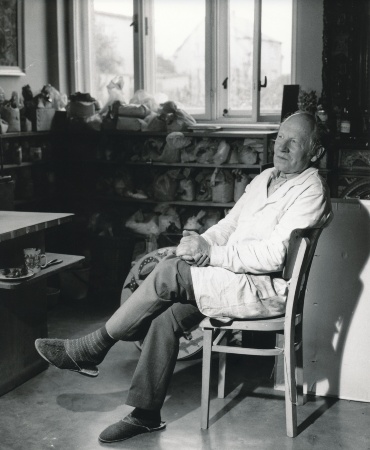
(1919–2010)
Work: We Learn from Nature
From the Life of Youngsters
Youth, Life, and Nature
Krystyn’s studies at the School of Arts and Crafts in Brno were interrupted in 1944 by deployment to a Prague factory. In 1945, Krystyn enrolled in the University of Applied Arts in Prague, where he graduated in the studio of the monumental painting under Emil Filla in 1950. In the 1950’s he painted the construction of the ironworks Klement Gottwald Nová Huť and portrayed its first employees. He gradually stripped his purely realistic painting style of details and gave it a significant impression. His landscapes and bouquets of flowers engage our attention by its multi-coloured, almost exaggerated colouring. Besides painting, he also devoted himself to ceramics. In addition to a number of works together with his wife Eva, he also cooperated with ceramist Lubor Těhník (a mosaic Family for the Cultural Centre of the company Pozemní stavby in Moravian Ostrava; a dividing wall for the Nová Huť in Ostrava-Zábřeh, 1965). Together with glassmaker Benjamin Hejlk, they designed decorative glass walls for the headquarters of the Ostrava-Karviná Mines (1965). Krystyn himself is the author of decorative grids in the apartment hotel owned by Vítkovice Ironworks in Ostrava-Zábřeh (1970 and 1971) or stained glass for the Spa House Petr Bezruč in Jeseník (Spa). He was a member of the Ostrava and Prague branches of the Union of Czechoslovak Fine Artists. He has participated in a number of foreign study internships.
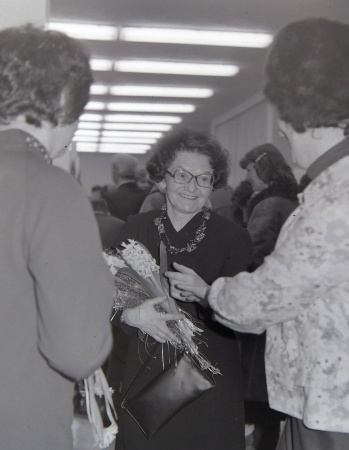
(1922–1987)
Work: We Learn from Nature
From the Life of Youngsters
Youth, Life, and Nature
Eva Krystynová was born in Skalica, Slovakia. From 1942 to 1948, she studied at the Academy of Arts, Architecture and Design in Prague under Karel Svolinský. From 1950, she worked as an art designer for the Children’s House in Prague. She moved to Ostrava with her husband in 1960 and until 1968 she worked as an art designer in the community centre in Ostrava-Poruba. Later, she became a freelance artist. Her work was inspired by the folk traditions of the Moravian-Slovak borderland and the children’s art. In cooperation with her husband Bohumír she also created a number of works for architecture. Their unmistakeable ceramic (sometimes in relief) mosaics have been used to decorate the building interiors of kindergartens (e.g. Ostrava-Zábřeh, Ostrava-Lhotka, Havířov, Frýdek-Místek), primary schools (Ostrava-Výškovice, Fulnek Special School), secondary schools (Secondary School of Chemistry in Ostrava-Zábřeh, restaurants (Ostrava – Mariánské Hory, Opava), shopping centres (Klimkovice), the Hrabyně rehabilitation centre, and others.
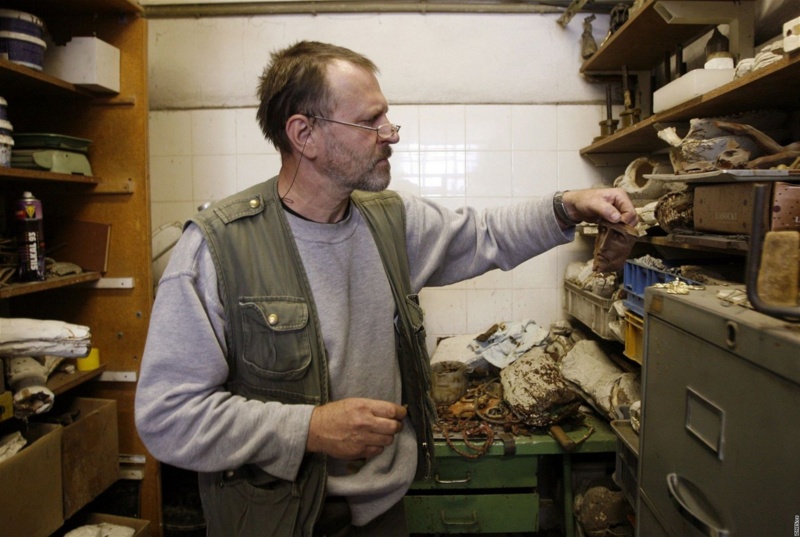
(1958)
Work: The Thinker
Jaromír Gargulák was born, lives and works in Brno. He came across sculpture through a purely technical, highly sophisticated technical field; he graduated from the foundry at Brno University of Technology, and he moved from disciplines focusing on precise casting to the sphere of artistic imagination. However, even freely expressive works cannot happen without the knowledge of materials and the sense of their physical, and eventually optical and haptic, qualities. As for spatial objects, the sculptor works exclusively with metal, using the technique of lost wax. He also uses wax to model his sculptures; he prefers this material for its formable, flowing nature since these characteristics are also reflected in Gargulák’s definitive author’s manuscript, characteristic of his bronzes. The initial wax model always perishes, smelts out of the mould, and therefore every piece only exists in a single cast. The sculptor works in brass, yellow and red bronze, lead, and steel. The sculptor has also been drawing intensely; the drawings, not just sculptural, fill in countless sheets of surreal creatures and objects seen both from the outside and in. The main motif is a face with an eye or a pair of eyes that continues to occupy the viewer’s attention, but also compels a look beyond the depicted and to seek encrypted meaning. Even in his early works, the author intensively addressed the empty, the negative space inside the plastic body. Gargulák’s sculptures are often spectacular in terms of both their shape and surface treatment. Visually, the contrasts between polished and roughened patinated surfaces are usually quite noticeable.
(*1938)
Work: Mining and Nature
Stanislav Martinec was born in České Budějovice. Between 1953–1957 he studied at the Secondary Technical School of Ceramics in Bechyně and from 1959 to 1973 he was a member of the KERAMO artistic production in Prague. Since 1973, he has been involved in free art creation. He almost exclusively uses sculptural methods to work with his ceramics (he is modelling from hand, as it is called) and thematically focuses on surrealistic imaginative expression. In his work, he likes to portray buildings, frequently ancient monuments, mirroring transience. He has often collaborated with the ceramist Ctirad Stehlík on architectural realizations. For example, in the Ostrava region, they together created ceramic reliefs for the Hotel Palace (1968), a sweet shop in the Ostrava-Poruba District VII, and a building of the Budoucnost cooperative in the District IV (1971), or bars at the Vlčina Hotel wine cellar in the mountain town of Frenštát pod Radhoštěm (1975). Other of Martinec‘s projects can be found in Prague and the Karlovy Vary area.
(1925–1990)
Work: The Fountain
The sculptor Jiří Myszak (1925–1990) was born in the fortress town of Terezín in the northern Bohemia. He graduated from the Academy of Fine Arts (1945–1950) in Prague under supervision of Karel Pokorný and Jan Lauda. In this way, he received a classical sculpture training that marked his initial work. He moved to Ostrava just before his graduation (1949). It was at a time when the massive post-war development of the city was being considered, which followed upon the reconstruction and expansion of the traditional heavy industry. Jiří Myszak had been given a great job opportunity, and together with Vladislav Gajda, they were asked to complete one of the first monumental tasks that consisted of the fittings on a building of flats on Hlavní třída (Main Boulevard) in the oldest district of Poruba, with allegorical figures entitled Industry, Culture and Agriculture. Also, he and Gajda had something in common – they were both Lauda’s students. And also, both Myszak’s teachers worked on the decoration of important public buildings in Ostrava at the time of the First Republic. Another principal task for Myszak and Vlastimil Večeřa was a fitting of an attic on the front facade of the newly built Vítkovice Ironworks House of Culture (then Vítkovice Ironworks and Engineering Works of Klement Gottwald, n.c., now the City of Ostrava House of Culture) with six figures in 1959–1960. Other monumental sculptural works of art followed, either in stone or increasingly more often in fireclay or finer ceramics. In the 1960s and in addition to clearly readable figural works, he started to devote himself to abstract forms – but he continued to make good use of the full volume and generously modelled mostly smooth shape. This ethos is common for both his concepts of the female body and non-figural objects.
Ostrava became Myszak’s main place of life and work until he was excluded from participation in major public space contracts in the seventies for his ideological unwillingness to submit to the communist regime. The family members recall that at that time he did not even feel like leaving his house-studio in Ostrava-Zábřeh. If he managed to get some work, it was – in the spirit of normalization – some „non-ideological,“ decorative or for utilitarian objects. They were most often jardinieres, which, on the other hand, is evidence of the decreasing funds for sculpture in the urban space. In the 1980s, Myszak attempted to recreate an ideologically motivated human figure (the figure of a schoolgirl Discoveries of Our Age / Atomic Age, approx. 1986), but it is obvious that it was a dictate that the author failed to fulfil. Today, we must do without some of Myszak’s works of art, especially those made of fireclay; many of those that found their place in public space were damaged or literally smashed.
(1887 – precise date of death unknown, assumed after 1969)
Work: Transfer of Experience
The personality of this artist gives a somewhat strange impression in the Czech environment. Damian Pešan was born in Prague and during his creative life worked as a sculptor and a woodcarver. He received his education at the School of Applied Arts in Prague (1908–1914 and 1920–1923), under supervision of Emanuel Novák, Jan Kastner, Celestýn Klouček, and Josef Drahoňovský. The training provided him with a unique preparation for the design and craftsmanship that could later apply in the field of applied art industry. One of the main objectives of education was to create a sense of material and the ability to combine individual art disciplines. Before the First World War, the school was also important as a starting point for artistic avant-garde. All this, combined with the work under architect Jože Plečnik, was a substantial contribution to Pešan‘s artistic career. Still, the art history literature is quiet about this artist; we can find only incomplete glossary information and his work is only reminded in connection with Plečnik’s architecture. At the turn of the 1920s and 1930s, Pešan created a bronze sculpture of two bulls carrying a canopy on the so-called Bull’s Staircase, which connects the passage from the third courtyard with the Na valech Garden (in Czech On A Fortified Line) at the Prague Castle, and seven years later wood carved the figures of Christ and six Czech patrons for Plečnik’s Church of the Sacred Heart of the Lord in Prague’s district Vinohrady. In the 1930s and 1940s, Pešan‘s woodcarving was also associated with the work for puppeteers, which was at the time when he taught at the State Central School of Housing Industry in Prague (it was established in 1921 as the State School for Wood Processing, today‘s the College and Secondary School of Applied Arts in Prague-Žižkov). There one can find original wooden furniture in the library and the principal’s office, where Pešan and František Kment have also incorporated their wooden statues.

(1920–2015)
Work: Takeoff / The Development of Human Thinking
The academic painter Martin Sladký, awarded in 1980 with the title of Meritorious Artist, was born in Hořice, Podkrkonoší region. During the war, he studied at the Academy of Arts, Architecture and Design in Prague, and after the war, he enrolled at the Prague Academy of Fine Arts, where he studied under the supervision of Professors Jakub Obrovský and Karel Minář. After graduating in 1950, he devoted himself to the 1950’s era typical motives portraying the working environment of workers and factories, metallurgical plants and mines. His first works for architecture include the design of stone mosaics, which won the architectural competition to decorate the railway station hall in Karviná (1961–1962). Here begins a series of his monumental works for architecture created by mosaic technique (the stone mosaic for the Centre of Services in a housing estate in Prague-Pankrác in the years 1965–1967, and the glass mosaic on the premises of the regional hospital in Ostrava-Poruba from the years 1967–1970). The author created many other monumental mosaics, especially during the 1970s, for various types of public buildings. This period also includes the circular mosaic Take off mounted on the ceiling of the lobby of the circular auditoriums on the campus of VŠB-TUO. At the end of the 1970s, the author received major contracts for the artistic decoration of the Prague Old Town and Lenin (today Dejvická) metro stations.
(1924–1994)
Work: Work
Rudolf Svoboda studied in the years 1946–1951 at the Prague Academy of Fine Arts under the supervision of Professor Karel Pokorný, and from 1947 to 1948 also at the Academy in Zagreb. Until the mid-1950s, he worked as Pokorný’s assistant and then devoted himself to his own creations. He became a Meritorious and National Artist (1988); he was a member of the Association of Czechoslovak Visual Artists, Society of Artists and the creative group October. His works of metal, stone and concrete are part of the public spaces of many Bohemian and Moravian towns and number more than forty. From significant realizations except for Ostrava in the VŠB-TU complex, important works include, for example, a fountain in the courtyard of St. George’s Monastery in the area of Prague Castle (1969, together with Vladimír Janoušek) and a kinetic time machine in the Mihulka Tower at the same place (1982), the bronze and granite Memorial of the Czechoslovak-Soviet Friendship in Pilsen (1981), the sculpture New Age in Frýdek-Místek (1981), the clock in front of the Florenc underground station (1985), etc. In Ostrava, he presented himself along with the painter Josef Peca in a group exhibition at Černá louka in 1965.
The sculptor coped very well with urban areas and coordinated his work with the architecture. He liked the themes in which he could develop movement without superficially describing it. Thematically, he touched on physical and spiritual uplift (Icarus, Return from the Universe, New Age…), freedom, motherhood; he connected with the humanistic roots of European sculpture (Greek sculpture, Michelangelo, Brancusi, Arp,…). In strictly stylized form, he focused on the expression, without exceeding the limit of non-figurative manifestation (Harlequin and Death, Juggler, and works against war and genocide, for example, Genocide, 1963, the relief Algiers, Wall). Perfectly wrought metal formally supported the themes relevant to the sphere of the progress of technology and civilization, as is the case in Ostrava-Poruba.

(1925–1990)
Work: Geology / Tree of Life
Josef Treuchel first completed his apprenticeship as a machine fitter and worked at the Tatra plant in Kopřivnice. There he started attending an art club run under a Factory Club of Revolutionary Union Movement, where he met the painter Helena Salichová, who brought him to the artistic creation. In the years 1952–1959, he studied painting at the Academy of Fine Arts in Prague under supervision of the landscape painter Otakar Nejedlý, later on under Antonín Pelc and Vlastimil Rada. In 1959 he became a member of the Union of Czechoslovak Fine Artists. Treuchel spent most of his life in Kopřivnice, the nearer and wider surroundings of which he often portrayed in his landscape paintings. The second characteristic feature of Treuchel‘s paintings is the sea harbours with boats that he had seen on his travels across Europe. Since the 1970s, he had also intensively depicted the industrial landscape of Ostrava. He has formally switched from realism to expressive and emotional capture of reality. His landscapes (such as the Hollow Way, Spring) or raw industrial scenes (such as the 1. května Coking Plant, a cycle the Birth and Mining of the Coal) often bear a symbolic dimension. For architecture, Josef Treuchel created mainly art-protis (his last art-protis work was the one for the Beskydy Theatre in Nový Jičín, 1990), but he is also the author of designs of two glass mosaics. He was a member of the Union of Czech Fine Artists and in 1983 he was awarded the award and title of a Meritorious Artist.

(1941‒2001)
Work: Geometric mosaics
Jan Václavík is a native of Ostrava living and working all his life in this city, a painter and teacher. Between 1962–1968 he studied figurative painting at the Academy of Fine Arts in Prague under Arnošt Paderlík. Václavík’s works of art, especially mosaics, found a place in public space (e. g. mosaics for the hotel Kalač in Nový Jičín, 1980, for the polyclinic in Kopřivnice, 1987, or a monumental mosaic The Heroism of Work in Ostrava-Hrabůvka, 1985) and concrete works (reliefs The Growth in the Šalamouna housing estate in Moravská Ostrava, 1971, The Spring April 30th in Moravská Ostrava, 1988, combined with mosaic, or a sculpture The Wings, ibidem, 1972, in collaboration with Václav Fridrich). His works on the borderline between fine art and architecture (e.g. concrete bus stops in Ostrava Kunčice) where he uses simplified shapes and compositions from geometrical elements, to which a motif of the mosaic in the Technical University student dormitories is also connected, are very impressive.
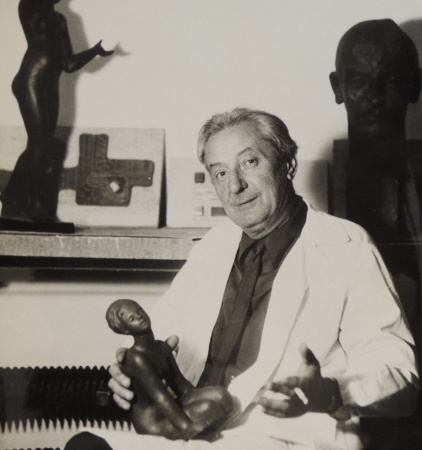
(1914–1982)
Work: Miner
Karel Vávra (1914–1982) continued the profession of his father Rudolf, who worked as a monumental mason in Ostrava. At the beginning of the 1930s, he developed his craftsman skills at the State Secondary School of Sculpture and Stonemasonry. Between 1932–1936 he studied at the Prague Academy of Fine Arts in the studio of Otakar Španiel. There, thanks to his teacher, he received substantial training on creating reliefs (1936 Diploma in Medallist specialization), especially in figurative composition and portraiture. From 1938 he worked in his father’s workshop of monumental masonry in Ostrava. During the post-war construction of Ostrava, Vávra’s stone reliefs were used for a number of public buildings and residential houses. In the 1950s, he created, for example, 12 sandstone reliefs of the Zodiac in a form of door-head arch keys above entrance ways off Gajdošova Street in Moravian Ostrava, together with others, with a motif of the Day and Night, at the same place they served on newly built blocks of flats as house signs. Figurative and emblematic reliefs still decorate the blocks in Moravian Ostrava, but also the façade of cultural facilities and administrative buildings (Antonín Dvořák Theatre and the former Stavoprojekt in Mariánské Hory). The second major scope of his sculptural work activities were memorials commemorating significant personalities or historic events. Several of them pay tribute to war victims. The most significant are two high-quality bronze reliefs on the wings of the Liberation Monument in Komenský Park in Moravian Ostrava (1945–1947); they were created in collaboration with the architect Jan Jírovec and the sculptor Konrád Babraj who is also an author of the main sculptural group. Vávra’s work also includes tombstones, marble altars and portraits. It is represented in the collections of the Art Gallery in Ostrava.
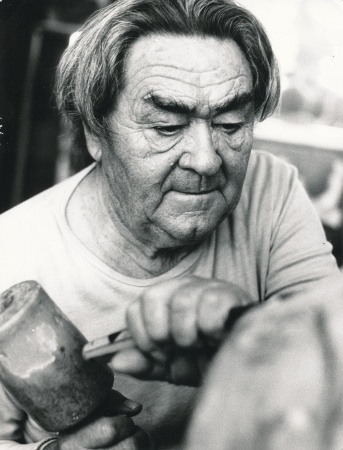
(1910-1998)
Work: Stéla
Mládí, Lidová píseň, Horníci/Práce, Láska, Rodina
Jindřich Wielgus studied at the Academy of Fine Arts at Karel Dvořák’s sculpture studio (1931–1934) and Otakar Španiel‘s medal specialist course, who also devoted himself to drawing, graphics and illustrations. With his Prague teachers, Wielgus met with the traditions of grandiose idealistic realism with Myslbek, and lyricism with Štursa. He studied both the Antique and Renaissance, the statue harmoniously composed, logically sculpted and firmly modelled. Regarding classical art of sculpture, Jindřich Wielgus also learned the principle of monumentality, which does not lie in scale, but in statue creation. During his study stay in Rome in 1938 he had his own exhibition.
Thanks to a substantial part of his work, Wielgus is regarded as a regional author essentially tied to the Ostrava area, despite the fact that he spent most of his adult life, from his studies to his death, in Prague. However, he repeatedly returned to Ostrava, both thematically and physically. He was a member of the Moravian Association of Fine Artists, cooperated with Moravian artists living in Prague and associated with the Aleš Association. He had repeatedly exhibited in the Art House in Ostrava. And so as in Prague he belonged to a generation of sculptors who gained a place in Czech art history (Karel Hladík, Alois Sopr, Jan Kavan, and Ladislav Zívr), Wielgus continued to cooperate with sculptural peers who never left the region (Antonín Ivanský and Karel Vávra). His encounter with the older Augustin Handzel, with whom he shared authorship of the non-pathetic but monumental sculptural representation of a hard-working man, also seemed to be essential for him. Wielgus‘s statues can be found in Ostrava, Opava, Havířov, Orlová, Karviná, and Frýdek-Místek. Working and politically determined people, such as are the iconic The Miner with The Block (1942–1945), were not the only subject theme of his works. In his portfolio, we also find an oft portrayed female figure, one with sometimes corpulent baroque shapes, and sometimes with a more delicate built and lyrical touch. Similar to other artists who worked and created in the 1950s and 1960s, Wielgus shows some influence by Henry Moore‘s work. He was freely approached in the sculpture of a sitting couple entitled Podvečer (Early Evening) (1963) on Poruba’s district Hlavní třída (Main Avenue), which is one of his best works created for the urban exterior.
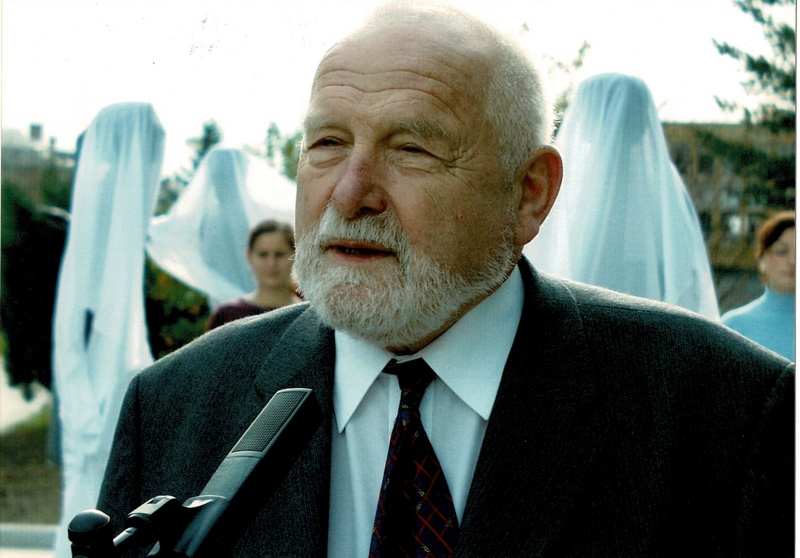
(1926–2017)
Work: People / Teachers and Students
The Prague sculptor Olbram Zoubek studied at the Academy of Arts, Architecture and Design in Prague in the years 1945-1952 under the supervision of Professor Josef Wagner. After graduation, in the period of socialist realism, he worked as a restorer, especially of Renaissance sgraffito. The same situation repeated after 1969 when he was allowed to exhibit his work in public spaces only sporadically. Zoubek cast the death mask and created the tombstone of Jan Palach, the student who burnt himself to death in protest against the entry of Soviet troops into Czechoslovakia in 1968. After that, together with other artists persecuted by the “normalization” regime, Václav Boštík, Zdeněk Palcr and Stanislav Podhrázský, he spent the following seventeen seasons restoring sgraffito on the Renaissance Chateau in Litomyšl. In his personal work, Zoubek mainly focused on the human figure, simplified, but with expressive, exaggerated gestures and expressions. He himself considers his statues classic, inspired by Mediterranean archaic sculptural tradition and Alberto Giacometti. Sculptures modelled from clay he mainly cast in cement, and later in bronze, smaller ones in lead and tin. He also polychromed parts of the sculptures and used gilding. After 1989, Olbram Zoubek returned to public life. His most significant achievements include the Memorial to the Victims of Communism in Prague’s Petřín (together with architects Zdeněk Hölzel and Jan Kerel). Olbram presented his lifetime work exhibition at the turn of 2013/2014 at the Prague Castle Riding School. His sculptures are part of many public and private collections.